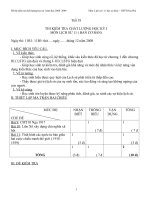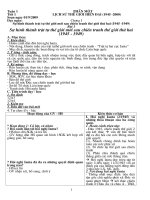28 11 K UBHH Prevention in TUMOR LYSIS SYNDROME
Bạn đang xem bản rút gọn của tài liệu. Xem và tải ngay bản đầy đủ của tài liệu tại đây (888.15 KB, 24 trang )
Prevention in
TUMOR LYSIS SYNDROME
Hemato-Oncology Department
Slide 1
Tumor Lysis Syndrome
• Caused by rapid & massive tumor cell lysis and release of
intracellular contents (potassium, phosphate and nucleic acids) into
the bloodstream that overwhelms the kidney’s ability to excrete
those products
• Can occur at presentation or more commonly after initiation of
chemo for high grade lymphomas (e.g., Burkitt’s) and leukemia
• Can also be precipitated by radiation, steroid or antibody therapy
• Risk of renal failure and life-threatening electrolyte disturbances is
caused by the breakdown of nucleic acids -> uric acid, which can
precipitate in the renal tubules
• Hyperphostatemia with deposition of calcium phosphate in the renal
tubules can also cause renal failure
Slide 2
Slide 3
Common Tumors Associated
with TLS
• ALL 63%
• Non-Hodgkin’s Lymphoma 18%
• AML 11%
• Solid Tumors 5% - Neuroblastoma; Medulloblastoma;
germ cell tumors; sarcoma
Slide 4
Risk Factors
• Patients with highly proliferative tumors and/or high
tumor burden (>10cm diameter; WBC>50,000)
• Pretreatment LDH > 2x upper limit of normal
• Pre-existing renal insufficiency
• Tumor with high sensitivity to treatment
Slide 5
Cairo Bishop Grading System
• Laboratory TLS requires 2 or more abnormal serum
values be present 3 days before or 7 days after
instituting chemotherapy in the setting of adequate
hydration and use of a hypouricemic agent
Slide 6
Cairo Bishop Grading System
• Laboratory tumor lysis syndrome:
Uric acid ≥8 mg/dL (≥476 mol/L) or 25% increase from
baseline
Potassium ≥6.0 mEq/L (≥6 mmol/L) or 25% increase
from baseline
Phosphorus ≥6.5 mg/dL (≥2.1 mmol/L) or 25% increase
from baseline
Calcium ≤7 mg/dL (≤1.75 mmol/L) or 25% decrease from
baseline
Slide 7
Clinical TLS
• Clinical TLS constitutes laboratory TLS plus at least one
of the following:
– serum Creatinine > 1.5 x ULN
– cardiac arrythmia/sudden death
– seizure
Slide 8
Clinical TLS
Grade 0†
Grade I
Grade II
Grade III
Grade IV
Grade V
LTLS
No
Yes
Yes
Yes
Yes
Yes
Creatinine‡
≤1.5 × ULN
1.5 × ULN
>1.5–3.0 ×
ULN
>3.0–6.0 ×
ULN
>6 × ULN
Death§
Intervention
not needed
Nonurgent
intervention
needed
Symptomatic
and
incompletely
controlled
medically or
controlled with
a device
Lifethreatening
(eg, arrhythmia
associated
Death§
with CHF,
hypotension,
or shock)
None
One brief,
generalized
seizure,
seizures
controlled with
anticonvulsant
drugs, or
infrequent
motor seizures
Seizures with
impaired
consciousness
, poorly
controlled
Status
seizures,
epilepticus
generalized
seizures
despite
medical
interventions
Cardiac
arrhythmia‡
Seizures‡
None
None
Slide 9
Death§
Clinical Manifestations of TLS
•
•
•
•
Nausea/Vomiting, diarrhea, anoxeria
Hyperkalemia
weakness, dysrhythmias
Hyperphosphatemia
hypocalcemia, renal failure
Hypocalcemia
muscle cramps, tetany, mental status
changes, seizures
• Hyperuricemia “uric acid nephropathy” = oliguria, renal
failure
Slide 10
Hyperuricemia
Slide 11
Hyperuricemia
Slide 12
Hyperphosphatemia
• Malignant cells contain higher concentration of
phosphorus
• Hyperphosphatemia causes hypocalcemia (precipitation
in renal tubules/heart is increased when phos*ca product
> 60 mg/dL)
• More common cause of renal failure since the use of
Allopurinol and UO
Slide 13
Slide 14
Slide 15
Prevention - Monitoring
• Follow laboratory parameters (UA, phosphate,
potassium, calcium, creatinine, LDH) closely, starting 4-6
hours after initiation of chemo & then every 6 hours
therafter
• Monitor UOP/Intake; monitor for seizures/cardiac
arrthymias
• Monitor for 24-72 hours after intiation of chemo
Slide 16
Prevention - Hydration
• Hydration to produce high urine output
– Fluid intake = 2-3 L/m2/day (or 200 ml/kg/day for
patients <10kg) enhances uric acid excretion,
phosphate excretion
– Goal UOP of 80-100 ml/m2 per hour (or 4-6 ml/kg/hr if
patient < 10kg)
– Use isotonic fluid: D5 1/4 NS or NS if hyponatremic
– Do not add calcium or potassium
• Monitor for fluid overload in patients with underlying
cardiac dysfunction or renal insufficiency
Slide 17
Prevention - Urinary Alkalinization
• Urine alkalinization - add NaHCO3 to IVF
– Uric acid more soluble at urine pH = 7.0 vs 5.0
– Goal of urine specific gravity 1.015 and pH 7.0-7.5
– Caution -- hypoxanthine and Ca-PO4 stones possible
if urine pH >7.5
• Fallen out of favor as no demonstrated advantage; may
be appropriate for patients with underlying metabolic
acidosis
Slide 18
Prevention - Hypouricemic Agents
• Allopurinol – a hypoxanthine analog that inhibits XO
producing more hypoxanthine and xanthine which are
more soluble in acidic urine; takes 2-3 days to be
effective
• Urate Oxidase/Rasburicase – breaks down uric acid to
allantoin which is more soluble in urine; acts within
several hours
• UO has significantly reduced the need for rescue dialysis
therapy for TLS
Slide 19
Prevention - Allopurinol
• Decrease production of
uric acid
– allopurinol inhibits
xanthine oxidase
• 300 mg/m2/day
divided tid PO/IV
• Dose reduction in
renal insufficiency
• Long-time standard
Rx
Slide 20
Xanthine
Hypoxanthine
xanthine
oxidase
Uric acid
Allopurinol
…Tumor Lysis Syndrome Prevention &
Management
• ALLOPURINOL:
-Competitive inhibitor of xanthine oxidase
which decreases conversion of purine
metabolites to uric acid. Used
prophylactically for TLS
-Prophylactic option for patients with a
medium risk of TLS
-Limitations:
----1)ineffective in reducing uric acid levels
before chemoTx
----2) Xanthine and hypoxanthine
precipitateobstructive uropathy
----3)reduces clearance of some
Slide 21 chemoTx
(azothiopurine & 6-mercaptopurine)
Prevention - Urate Oxidase
• Present in other
mammalian species
• Catalyzes conversion of
uric acid to allantoin
– Allantoin more
soluble, easily
excreted by kidneys
• Urine alkalinization
unnecessary if used
• Recombinant urate
oxidase (rasburicase)
more effective than
allopurinol in prevention
and treatment of
hyperuricemia
–
Goldman SC et al. A randomized
comparison between rasburicase and
allopurinol in children with lymphoma
or leukemia at high risk for tumor lysis.
Blood. 2001;97:2998-3003.
• Contraindicated with
G6PD deficiency, asthma
Slide 22
…Tumor Lysis Syndrome Prevention &
Management
• RASBURICASE (recombinant urate oxidase) :
-promotes catabolism of uric acid:
Uric acid allantoin (10x more soluble than uric acid)
-100 adult pt (w/ aggressive NHL) got 3 to 7 days of
rasburicase beginning day 1 of chemo:
1)Uric acid levels decreased w/i 4 hrs of rasburicase
2)Normalized uric acid levels maintained throughout
chemo
3)No increase in creatinine observed
4)No patient required dialysis
-One European and one US study showed that
rasburicase prophylaxis resulted in net savings in health
Slide 23
care costs ($9,978 for 7 day stay VS. $51,990 for 21 day
stay w/ HD)
Conclusions
• Pediatric oncology patients experience a broad variety of
critical illnesses related to both disease and therapy.
• Long-term survival for many pediatric cancers is
improving.
• ICU outcomes for this patient group is improving.
• Good ICU care can benefit children with malignancies.
Slide 24









